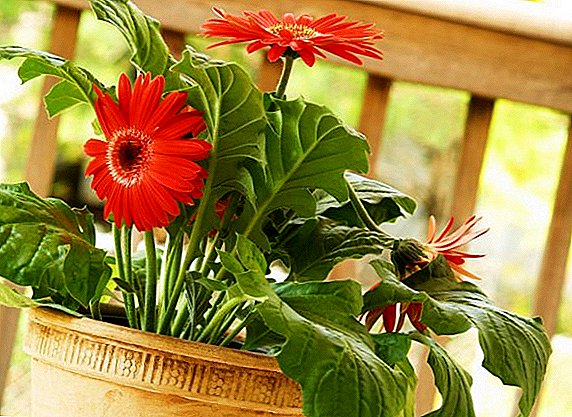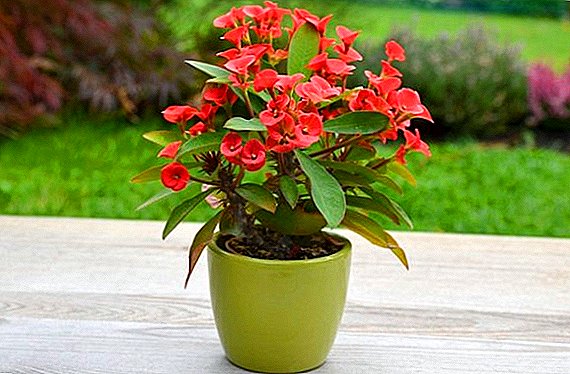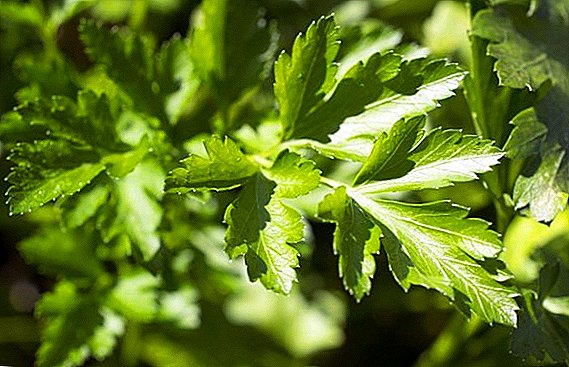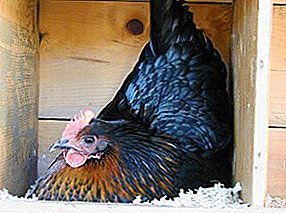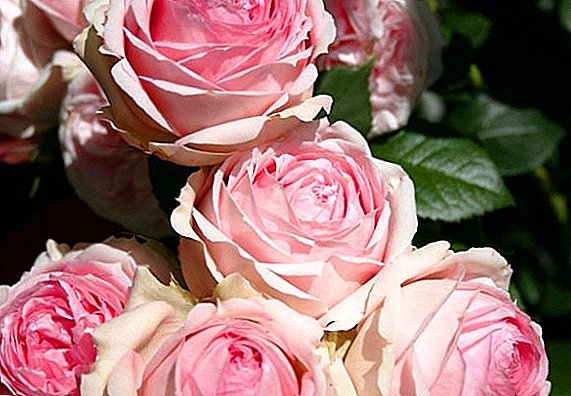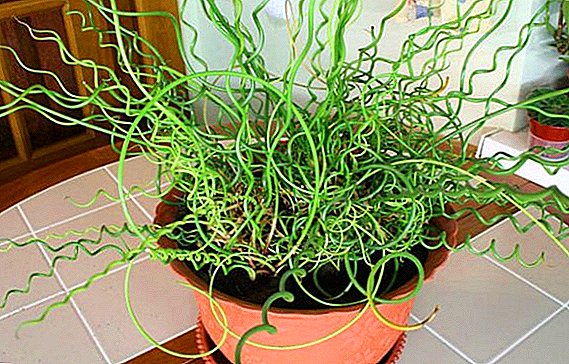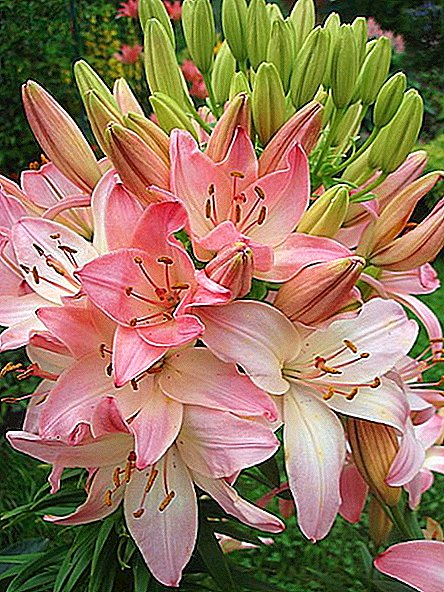 Lily is one of the most ancient flowers. The history of its popularity is calculated not for years, but for centuries and even millennia. This flower is mentioned many times in the Bible, it is found in ancient manuscripts. And on the oldest frescoes you can see his image. In nature, there are about 80 species of lilies. Of these, breeders brought thousands of hybrid varieties, which are divided into groups. The most common group of hybrids is Asiatic lily.
Lily is one of the most ancient flowers. The history of its popularity is calculated not for years, but for centuries and even millennia. This flower is mentioned many times in the Bible, it is found in ancient manuscripts. And on the oldest frescoes you can see his image. In nature, there are about 80 species of lilies. Of these, breeders brought thousands of hybrid varieties, which are divided into groups. The most common group of hybrids is Asiatic lily.
Botanical description
Asiatic lily is not one variety, but the whole group, which includes about five thousand varieties. Their parents chose the eastern species of lily: pleasant and drooping, David and tiger, dwarf and Maksimovich, onion and monochromatic, Dutch and spotted, bulbous, Dahurian and others.
Asian hybrids are winter-hardy and unpretentious, as well as a large variety of shapes and colors. Asian varieties have different heights: they can be short (up to 50 cm) and high (up to 1.5 m). The flowers are often cup-shaped or turbid-like, the size varies from 8 to 20 cm in diameter.
The color spectrum is very wide: from light soft tones (white, cream, yellow) to bright (sunny orange and fiery red). There are varieties of two and three colors. Located on top of the stem, the flowers can look up, down and to the side.  Unlike other lilies, Asian ones do not smell. But they bloom earlier than other species: in late June - early July. Reproduced scales and children. And on some varieties (bulbous) in the axils of the leaves appear air bulbs or bulbs, with which they multiply.
Unlike other lilies, Asian ones do not smell. But they bloom earlier than other species: in late June - early July. Reproduced scales and children. And on some varieties (bulbous) in the axils of the leaves appear air bulbs or bulbs, with which they multiply.
Did you know? In Russian, this flower gave the name to the female name Lilia, and in Hebrew - Susanna (from the Hebrew “shushan” is translated as “lily”).
Spread
Oriental countries are considered the birthplace of lilies. According to one version, the flowers appeared in Europe thanks to the Crusaders, who brought from the crusades among other trophies and lily bulbs. To adapt oriental flowers to the climatic conditions of different countries, breeders from Japan, Europe and the USA set to work.
In the territory of Russia (then the Russian Empire) at the beginning of the 20th century, I.V. was the first to engage in the hybridization of lilies. Michurin. Now lilies, in particular, varieties of the Asian group, distributed throughout Asia, Europe, the United States and Canada. 
The onion flowers also include: gladiolus, babian, zephyranthes, ixia, crocus, candyk, licoris, narcissus, dahlia and allium.
What distinguishes oriental lilies from Asian
From the name we can conclude that the Eastern and Asian lilies are identical. Actually - these are two different groups of hybrids. The Asian group includes 30% of all varieties of lilies. This is the most common group in the world. The second place in popularity is occupied by eastern hybrids. 
These two groups have significant differences:
- Oriental hybrids are very whimsical, they need fertile, loose soil. Asians, by contrast, are undemanding in this regard.
- Asian beauties are not afraid of frost, they do not need to be prepared for winter. The eastern ones should be sheltered for the winter or completely dug out so as not to freeze.
- Asians bloom before all other lilies, including Oriental.
- Unlike Asian women, Eastern varieties require special care, as they are prone to most lily diseases.
- Oriental beauties have two significant advantages: they are considered the most beautiful, exude a pleasant aroma. Asians have no smell.
Did you know? In his famous Sermon on the Mount, Jesus Christ said that the lilies of the field look much more beautiful than King Solomon in his royal robes.

Asian lily varieties
The variety of varieties of Asian hybrids rank first among other groups of lilies. Thousands of Asians are grouped by certain attributes. It turned out several varieties.
Familiarize yourself with the nuances of growing Marlena lily, tiger lily, and lily tree.
Brashmark (from the English. "brush stroke"). A common feature of this group are smears on all tepals. The shapes and sizes of the patterns are different: thin, like a pencil mark, and thick, resembling brush strokes of the artist. Patterns are painted in different colors: from very light tones (cream) to dark and bright (dark purple). The intensity of the color is often affected by the weather.
The following varieties can be called the most popular among the Brashmark hybrids:
- Or me (cream flower with orange center and dark smear);

- Vangard (golden-orange lily with a bright brushstroke of red currant color);

- Rostani (a light-apricot flower, and a smear dark);

- Zhuravinka (red lily with a dark pattern);

- Delta (it is painted in saturated yellow color, with brown smear, it blooms for a very long time).

Two-color hybrids. A characteristic feature is that the flowers are painted in two or three tones, which gradually merge into each other.
In this group, the following varieties are in demand:
- Asenny Farby (red lily with orange center);

- Sorbet (soft pink flower with a white center);

- Grand Cru (the flower is colored bright yellow, and a red spot is burning in the center).
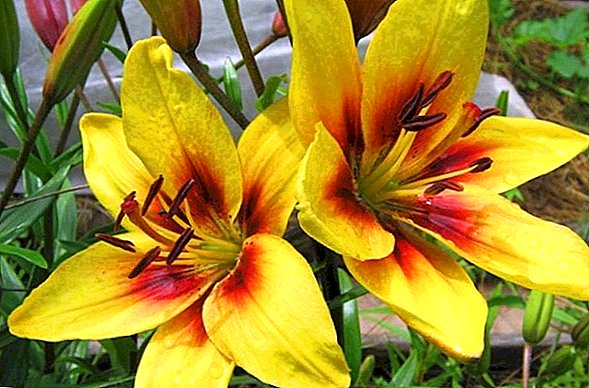
Tango different thick spotting in the center. The most beloved of this group is the lily Yazon of yellow color, which is decorated with dark brown substance.
Pixie- the group consists of mini-lilies not higher than 40 cm. There are not so many representatives of this variety group. Most of all fell in love with a miniature lady Butter Pixie with large flowers, painted in lemon-yellow color and with a golden spot in the center.
Terry varieties. Velvet petals give flowers a luxurious look. The brightest representative of terry lilies is Fata Morgana. 
Growing at home
Growing Asian hybrids in a flower bed near your home is a snap. Unpretentious flowers do not need special care and conditions. It is enough to choose a suitable place for planting, time to fertilize and replant the bulbs.
Choosing a landing site
Lilies - perennials. Therefore, onion plants should be planted immediately to a permanent place where they can grow for 3-4 years. After this period, flowering stems usually become shorter, and they have fewer flowers.
Next to the main stem can grow several small stalks, which signal that a lot of new bulbs have formed, and they are closely in the nest. All this means that the time has come to dig out, divide and transplant the onions to a new place. If you do not, then the bush is likely to get sick and disappear.  For Asians, you need to choose a well-lit area, partial shade is allowed. With a lack of sun, the stems will reach for the light and bend. Ideal - the buds in the sun, and the lower part of the plant in the shade. This can be achieved by covering the ground with a thick layer of mulch that will retain moisture. You can also plant stunted neighbors next to the lily bushes, which will create a shade for the roots.
For Asians, you need to choose a well-lit area, partial shade is allowed. With a lack of sun, the stems will reach for the light and bend. Ideal - the buds in the sun, and the lower part of the plant in the shade. This can be achieved by covering the ground with a thick layer of mulch that will retain moisture. You can also plant stunted neighbors next to the lily bushes, which will create a shade for the roots.
The advantage of Asian hybrids is their winter hardiness. They are not afraid of either cold or frost. Therefore, there is no need to dig the bulbs for the winter. In the snowy winter to cover them, too, is not necessary. If winter does not bring snow with itself, then it is advisable to cover the bushes with mulch.
Soil and fertilizer
Although Asian unpretentious, they do not like limestone soil. They are suitable neutral or barely sour earth (pH 6-6.5). Suitable soil composition: peat, loam, leaf humus, compost (but not fresh), ash and bone meal.
We recommend reading about what types of soil exist, how to independently determine the acidity of the soil at the site, and also how to deoxidize the soil.
 Before planting, it is advisable to pour sand into each well, which will act as a drain and absorb excess moisture. Before planting the bulbs, you can saturate the earth with mineral fertilizers, but without nitrogen. For feeding, a solution of potassium nitrate is often used.
Before planting, it is advisable to pour sand into each well, which will act as a drain and absorb excess moisture. Before planting the bulbs, you can saturate the earth with mineral fertilizers, but without nitrogen. For feeding, a solution of potassium nitrate is often used.
Lilies need to be fed 2-3 times a month, starting from the second week after planting. Feeding is particularly important during the formation of buds. But during the flowering period you should not feed up, otherwise this process will be accelerated.
Important! Asian lilies do not like fresh organic fertilizer (manure) and a surplus of nitrogen.
Watering and moisture
Asian Lily easily withstands temporary drying of the soil and does not tolerate stagnant water, because of which it can get sick. For Asians, it’s better not to drink than to drink. On the other hand, constant drying is also undesirable: the plant becomes weak, loses growth, and the flowers become less beautiful.  The best condition of the soil is moderate humidity. This will help, as already mentioned, mulching or planting between the lilies of undersized perennials to create a shadow over the roots and obstructing their drying. Watering should be plentiful and as the soil dries.
The best condition of the soil is moderate humidity. This will help, as already mentioned, mulching or planting between the lilies of undersized perennials to create a shadow over the roots and obstructing their drying. Watering should be plentiful and as the soil dries.
In dry weather, this should be done once a week. It is desirable to carry out watering under a root in the first half of the day, so that by the night the ground has time to dry on top. After stopping flowering should stop and watering. An exception can only be a very hot autumn.
It will be useful for you to read about why the leaves turn yellow, how to protect the lily from diseases and pests.
Breeding
Asian lilies can be propagated in four ways. The first three are related to the bulb. The fourth method is reproduction by stem bulbs. Consider each of them in more detail.
Onion
- Bulb division. From the very first year after planting the bulbs, new small bulbs start to appear in its pallet.
 Of them still do not grow shoots. But if they are separated, they will give a new high-grade plant. If necessary, in the autumn of a large onion should be a little dig, disconnect the small onion and immediately plant them in a place prepared for them. After four years, this procedure is simply necessary, as the bulbous nest becomes very cramped. In addition, additional bulbs already produce lateral stems that interfere with the normal development of the main.
Of them still do not grow shoots. But if they are separated, they will give a new high-grade plant. If necessary, in the autumn of a large onion should be a little dig, disconnect the small onion and immediately plant them in a place prepared for them. After four years, this procedure is simply necessary, as the bulbous nest becomes very cramped. In addition, additional bulbs already produce lateral stems that interfere with the normal development of the main. - Children they are formed not only on the bulb, but also in the root part of the stem. They are called air bulbs. For seating them are separated from the stalk and deposited in a new place. At the same time, the main bulb is not affected at all. The procedure takes place in the fall.
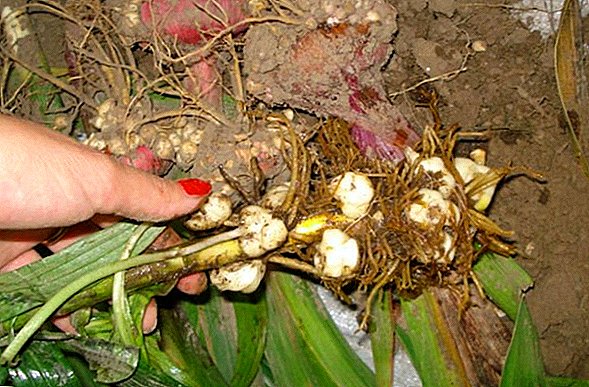
- Scales. Lily bulbs are not dry and thin scales, but fleshy and juicy. They serve as an excellent planting material. To obtain it you need to dig a bulb without damaging it, carefully separate the scales. They can take as much as you need, but not more than the third part. They are immediately thrown into the ground, but not deep. Each scale is placed in a hole and sprinkled with sand, but it is also possible with sawdust. If you water them every day, then within a few weeks new sprouts appear. This method of breeding lilies is effective both in autumn and spring.
Video: lily breeding scales
Stem povkolukovichkami (bulb)
Among Asian hybrids there are varieties that breed by bulbs growing on stalks. They resemble onions, which form small scales-leaves.
They themselves fall from the mother plant, take root and germinate. They need to be collected on time and planted in the right place in the same way as root bulbs. New lilies bloom only in two years. 
Planting lilies
For planting you need to take quality planting material. Only in this case healthy and beautiful flowers will be obtained. The bulbs must be solid, free from damage and other visual imperfections.
We recommend reading about the best time for transplanting lilies, as well as how to plant a lily in the fall.
To disinfect them, they should be treated with a solution of karbofos or a foundation. To store the bulbs should be left in a room where it is dark and cool, and cover them with moss, sawdust or moistened cloth with a cloth.
Important! The flowering time depends on the size of the planting bulb. A shrub grown from a large onion will bloom in the first year, and from a small one in the second.

When to plant lilies
You can plant lilies at any time of the year, except for winter. But still preferred landing seasons - spring and autumn. Asians often land in the ground in March, after snow melts.
The advantages of spring planting:
- in the ground the bulbs will not be soaked or frozen over;
- they better root and take root.
Many gardeners prefer autumn planting lilies. The roots have time to develop enough to survive the winter. Even severe frosts are not terrible, if the bulbs planted cover.
Planting lilies in the spring
When planting lilies, you need to remember the rule: the larger the bulb, the deeper it needs to be planted, and the deeper it sits in the ground, the later it will bloom. The depth of the fossa also depends on the height of the future plant: for low varieties, a hole of about 10 cm deep is prepared, medium varieties - about 15 cm, and for tall bushes - 20 cm.
Video: how to plant lilies in spring Cooked holes or trenches of the desired length can be fertilized with humus or compost. The bottom of the fossa is covered with sand, onion is carefully placed on it, then it is covered with sand first and then with earth. The landing site is well watered, and then mulched with peat or sawdust (5 cm layer).
Planting lilies in the fall
Purchased bulbs are planted in the fall on the same principle as in spring. But more often, in the autumn, the bushes that are already growing in the ways described above are divided and planted in the autumn: babies, bulbulas and scales are planted in the ground.
Particularly in need of this three-and four-year plants. Transplantation can be carried out without waiting for the fall, 1-1.5 months after the end of flowering. Many Asian varieties can be seated in August.
Video: planting lilies
Lily care
It is easy to care for lilies, especially Asian ones. We have already discussed the main points: regular watering, proper feeding and timely transplanting. You must also be prepared for possible difficulties.
How to care for lilies in the garden
Unlike other hybrid groups, Asiatic lily is not afraid of winter. She is not afraid of severe frosts, especially if the beds are covered with snow or mulch. No need to dig out the bulbs before the onset of cold weather.
But if the bulbs are still dug up or bought, and before the planting time is still a long time, then they need to ensure the proper storage conditions. The air in the storage should not be very dry or very humid, cold, but not frosty. The room should be well ventilated.  This storage can serve as a basement, loggia or even a refrigerator. Before you take the planting material to the place of storage, it must be placed in a container (box, box, bag), laying out the bulbs in layers and sprinkling them with peat.
This storage can serve as a basement, loggia or even a refrigerator. Before you take the planting material to the place of storage, it must be placed in a container (box, box, bag), laying out the bulbs in layers and sprinkling them with peat.
So that the contents of the box do not dry out, it must be sprayed with water from time to time. Thus, the bulbs will remain in good condition and wait in the wings.
Possible difficulties in growing lilies
With the cultivation of Asiatic difficulties rarely arise, but still there are. We will discuss their causes and methods of struggle.
- Flowers quickly fade. Possible reasons: the soil is very wet and water stagnates in the roots, or, conversely, the ground and the roots strongly overheat. From overheating, you can save the plant mulch (sawdust, grass, straw), which will reflect sunlight.
- Bushes often get sick. Reason: fertilizer with fresh manure, which can be a source of harmful bacteria. Lilies do not tolerate fresh organic fertilizer. You can use well-rotted compost or humus, which is at least 4 years old.
Pests, diseases and prevention
- The most dangerous pest for lilies is red lily beetle. He and his larvae devour the leaves and buds. Beetles appear in flower beds in April. Usually at this time they can be collected by hand. But if they managed to make a big difference, then a more powerful "weapon" should be put into action. With the lily beetle can be fought by the same means that destroy the Colorado potato beetle. The disadvantage is that after spraying with chemicals, plants, including flowers, are covered with brown spots.

- The most dangerous disease threatening Asians is botrytis or gray rotwhich affects all ground plant, but does not touch the bulb.
- Symptoms: rusty and brown spots crawl all over the bush, which becomes brown, and then dies.

- The reasons: prolonged rains, due to which the soil overflows with moisture, temperature drops, poor care, thick planting, a lot of weeds.
- Treatment: remove diseased leaves, sprinkle the remaining shrub with Bordeaux mixture (1% solution) or foundation (10 liters of water 20-30 g), after flowering, completely cut off the bush and destroy it.
- Prevention: Mix the solution of copper sulphate (1 tablespoon per 5 liters of hot water) and mix with liquid ammonia solution (1 tablespoon. Ammonia and 1 tablespoon. Soda ash to 5 liters of cold water) and pour small sprouts from the watering can 8-10 cm), or in May, treat the plants with open leaves with a solution of copper oxychloride (50 g per 10 liters of water).
Lily after flowering
After flowering, remove the seed boxes, if there is no need to collect the seeds. А стебли с листьями остаются стоять до тех пор, пока не пожелтеют и не завянут.If the weather is hot, then you need to continue to water the plants, as they supply their bulbs with the necessary nutrition.
Learn how to care for lilies after flowering, as well as how to prepare lilies for winter.
Video: care for lilies after flowering In the autumn the bush is cut off. After that, lilies can be transplanted. Before the onset of frost, the bulbs should be covered with mulch. Cut bushes are not suitable for compost.
A huge selection of varieties of Asiatic lilies can satisfy even the most sophisticated taste. And thanks to their unpretentiousness, the summer flowerbed will bloom in a wild color, even with minimal effort and time.










 Of them still do not grow shoots. But if they are separated, they will give a new high-grade plant. If necessary, in the autumn of a large onion should be a little dig, disconnect the small onion and immediately plant them in a place prepared for them. After four years, this procedure is simply necessary, as the bulbous nest becomes very cramped. In addition, additional bulbs already produce lateral stems that interfere with the normal development of the main.
Of them still do not grow shoots. But if they are separated, they will give a new high-grade plant. If necessary, in the autumn of a large onion should be a little dig, disconnect the small onion and immediately plant them in a place prepared for them. After four years, this procedure is simply necessary, as the bulbous nest becomes very cramped. In addition, additional bulbs already produce lateral stems that interfere with the normal development of the main.


